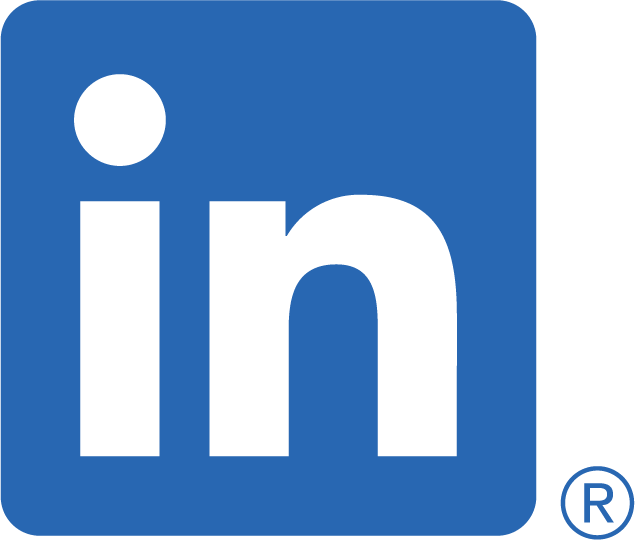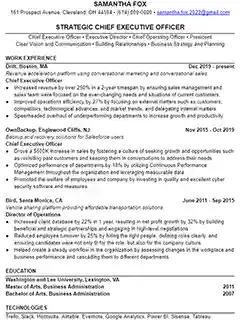CEO Resume Example
Leet Resumes can help take your career to the next level with a great CEO resume. Either follow our step-by-step writing guide below, or we can write yours for free.


How to write a great CEO resume
There’s a stereotype out there that CEOs spend all day playing golf and answer to no one. You know that with great success also comes great expectations - and accountability.
You answer to far more than just one boss: The board of directors, shareholders, your own employees, and the general public.
Sure, you may enjoy plenty of praise when business is good, but you also face all of the blame when problems arise.
You're both the leader and the public face of your company, and that means the status quo is your worst enemy. If the company isn’t constantly growing and improving, it just might be regressing.
The same applies to your career. If you’ve been feeling stagnant in your current role, it may be time to update your CEO resume and start exploring new opportunities.
In need of a resume-writing refresher? Just follow our easy step-by-step guide for creating a great CEO resume.
Leet Resumes can always write your CEO resume for free. We’ve written thousands of resumes and we’re ready to write yours! Tips appreciated.
Click here to get started today.
Why you need a great CEO resume
Here’s a misconception: Successful CEOs don’t need a resume.
Wrong!
Everyone needs a great resume, even seasoned CEOs with years of experience.
In fact, the more experience the better. You’ve accomplished a lot in your career, now it’s time to make sure the right people know what you have to offer.
On the other hand, if you’re an up-and-coming executive looking to take the next big step in your career, a compelling CEO resume is invaluable.
A great resume will tell the story of your career clearly and concisely. All within a matter of seconds your resume should convey to readers who you are, what you’ve done in the past, and what you’re ready to accomplish next.
“Seconds” may sound like an exaggeration. It’s not.
CEO jobs are coveted positions. That means you’re going to be competing with a ton of other applicants. Hiring managers and decision makers will read your resume for just a few moments before making an initial call.
You know you’re the best fit for the position. The tricky part is making sure readers see that as quickly as possible.
The best way to do that? By following our step-by-step resume writing guide. We’ve written thousands of resumes, and developed the ideal resume format.
How to format your CEO resume
When people talk about “wearing many hats on the job,” they’re talking about you.
Let’s face it: As CEO, you set the tone for the entire company. You’re involved in every big decision, and most of the small ones too.
You’re constantly planning for the future by mapping out strategic profitability and expansion goals. But, at the same time, you know the best way to ensure success tomorrow is by improving today.
How in the world can you convey all of that within a single page resume? By following this format:
- Name + Contact
- Professional Headline
- Professional Summary
- Work Experience
- Education
- Keywords
Simple, right? Resume writing isn’t rocket science. Your successes will speak for themselves. This format just provides the right structure.
Now, let’s touch on each specific resume section in greater detail.
If you would rather have someone else write your CEO resume, you can always get in touch with Leet Resumes.
Name + Contact
No need to overthink this one. Place your name in slightly larger text at the very top of the page, followed by your contact information (professional email, phone number).
Be sure to keep all of this information 100% professional. Don’t use a silly or goofy email address. It’s a small detail, but the little things matter.
Only include your LinkedIn profile if you log in every single day. Otherwise, you risk missing out on a recruiter trying to reach you for a job interview.
Professional Headline
It’s time to start grabbing the reader’s attention. If you paid for a billboard to advertise your career, what would it say in big, bold letters? That’s your professional headline!
Summing up your career and workstyle in just 3-5 few words isn’t just possible, it’s easy. Just start with a positive, somewhat flattering adjective, then add your current title / level of seniority.
A few examples:
- Innovative Tech Executive
- Results-driven Chief Executive Officer
- Dedicated CEO
Professional Summary
Now that you’ve gained the reader’s attention, it’s time to dive into the details of your career. If your professional headline is a billboard, the professional summary is your full-blown career commercial.
Depending on your level of experience, this section will contain at least two lines or as many as four. After reading your professional summary, the reader should know about your biggest career wins, the most advantageous skills you offer, and the ideal job you’re looking to accept as your next role.
Let’s break it down line by line:
Line 1 is for listing job titles you want to accept as your next role, such as “Chief Executive Officer” or ”Senior Executive”.
Line 2 is where you will list a few of your most desirable professional skills. Examples may include leadership, communication, decision making, corporate financial acumen, and strategic business planning.
Line 3 (optional) is for displaying any relevant achievements or accomplishments you’ve earned during your executive career.
Line 4 is optional as well. If you’ve earned any promotions or awards during your career, place them here.
Work Experience
This is the main body of your resume, where you’ll list your job history in reverse chronological order. So, your most recent or current position should be at the very top.
A strong work experience section is key to landing job interviews, so here are some important tips to keep in mind:
Focus on your career wins
It’s a major mistake to just list your expected duties and responsibilities under each job title. You’re writing an eye-catching resume, not an instruction manual on how to manage.
Decision makers want to know what elevates you above other candidates - and there’s no better way to express that than by emphasizing your career wins.
For instance, If you increased company profits or oversaw a successful expansion into a new marketplace, now’s the time to talk about it!
Use as many numbers as possible
We recommend using as many numbers, statistics, and metrics as possible in your work experience section. Words can be vague and misinterpreted, but numbers are undeniable.
Get specific. Just how much did your company’s market cap increase under your leadership? How far did stock prices rise? Maybe you had to clean up a certain department or put a new business plan in place; by what percentage did productivity increase afterward?
Once you think you’ve added enough numbers, add a few more! You can thank us after you’re contacted for more job interviews than your schedule can handle.
Verbs are your friend
Here’s a trick to help bring all of this advice together. Each position listed in this part of your resume should be followed by 3-5 bullet points laying out your biggest achievements.
For each and every bullet point, start the sentence with an action verb (improved, increased, led, etc) followed by an achievement supported by a number or statistic.
“Increased company revenue by over 70% in a two year span.”
Extra tips to keep in mind
Never write any paragraphs on your resume. Remember, brevity is essential. A wall of text anywhere on your resume is going to throw up a red flag to most recruiters. Similarly, avoid using any colors besides black text, and resist any urges to add sub-columns or smaller text boxes.
One may argue that visual additions like these add personality, but all they really do is make it harder for readers to get to the point.
Education
You’re almost done with your new CEO resume!
Here you’ll write down your education history. Include all of your completed degrees, such as an MBA, dating back to your Bachelor’s degree.
Always note the institutions and programs you graduated from, and be sure to add accurate attendance dates.
Keywords
The final section of your resume can still make or break your job prospects, so it’s important to finish strong. This area is for listing any additional hard skills, soft skills, or awards that you haven’t mentioned yet.
Here are just a few relevant CEO resume keywords you may want to add:
- Business law
- Risk management
- Organizational restructuring
- Decisiveness
- Strategic planning
- Complex problem solving
And that’s that. Your new resume is done!
You don’t have to write your resume
Even with this guide in hand, resume writing can feel like a drag. The good news is we can write you a great CEO resume!
We write resumes for free. Tips appreciated!










